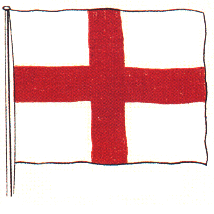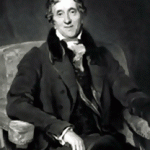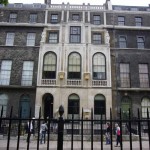February 14th, 2010 · 1 Comment

historic-uk.com

bbc.co.uk
For my paper assessing the perceived recent revival of specifically English identity, my experiential component will hopefully be a patchwork of interviews, participant observation, and attending of events related to political organizations and causes connected to English identity, such as the Campaign for an English Parliament. Last Saturday, I decided to start my experiential off in sort of the shallow end with some participant observation of an England v. Wales Six Nations Rugby Match at the Murderers Pub in the City Centre.
While my paper is likely to focus more on the political and social implications of a rise in English Identity, cultural institutions and particularly sports teams are some of the most visible institutions which divide the UK. Rugby, like football and cricket, is one of the sports in which England, Scotland, Wales and Northern Ireland compete separately in international competitions, and I’d hoped watching the behaviour of English Rugby supporters (especially interaction with Welsh supporters and the ways in which they showed support for their team) would give some indication of where investment in national sports teams fits into this rise in English identity.
The crowd in the Murderers Pub was substantial on this Saturday afternoon, large especially given the fact that the rugby was live on BBC One, so it was hard for me to find a perch from which I could best observe things. The majority of the crowd were white men between about thirty and sixty, about ten of whom were wearing England rugby apparel and watching on the large projector screen. The rest of the patrons, however, seemed just as likely casual fans of rugby than England die hards. I was glad to see that there were a decent number of Wales supporters as well, and they made a decent roar when the Welsh scored. These ex-pats seemed much more likely, percentage-wise, to be wearing Wales apparel than their English counterparts did English apparel, and one older woman was even wearing a Welsh flag sort as a sort of cape. One interesting thing about England v. Wales is that essentially the English are taking their opponents on at their “national” sport. Although I could not record every interaction between the English and Welsh supporters, things generally seemed very cordial, without too much interaction at all between supporters.
Also, I was looking to see what symbols are associated with support of the English national team, and was a bit surprised. I saw very little of the Cross of St. George (which is likely to be a focus of the paper, and actually flies above the door at the Murderers). While the St. George flag has become identified more and more with England Football, the rugby team uses another symbol of Englishness, a red rose, on their jerseys. This underlined my most significant observation of the day: support of this national team does not seem to be conflated with any sort of political nationalism in the least, at least for Rugby supporters. For example, when England made the decisive score towards the end, the core group of England supporters did not belt out God Save the Queen, as England football fans sometimes do at such a moment (even, presumably, when playing another British team). Rather, they sang the American spiritual Swing Low, Sweet Chariot, which became associated with the English national team about twenty years ago. This may have to do with the English rugby still feeling like almost a niche sport and community compared especially to football in England, and so rugby fans have developed their own unique rituals to distinguish themselves. After all, when the English football team wins a big match, it generally is a moment of unusual English national unity deserving of God Save the Queen, whereas interest in English rugby still doesn’t seem to cut across the whole of society in that way.

irishrugby.co.uk
I hope to apply these very preliminary findings to my research and experiences in the coming months on the cultural side of English identity. Oh, and England won by a final score of 30-17, and I pretty much have the rules of the sport down now. Give rugby a shot if you haven’t yet, it’s actually very watchable. And I can’t recommend the Murderers highly enough either.
Tags: Aidan
September 13th, 2009 · 1 Comment
I have been given further thought on the issue of identity in London. After reading Prof. Quall’s thoughts on the rebuilding of Sevastopol, I asked myself, how does London reflect its people’s identity, if it does at all. I am a firm believer in materialism, and in that ideology is reflected in every building and site that surrounds us. The sites that we visited, those that are known as “religious”, like St. Paul’s, the Sikh Gurdwara and the Shri Swaminarayan Mandir, will articulate the ideology behind the religion. By this I mean the myths of origin, the “imagined communities” of the particular ethnic group we are looking at. For example, at the Shri Swaminarayan Mandir, we could appreciate pictures from every temple there is throughout the world. This is a clear connection to Benedict Anderson’s concept of “imagined communities”; the idea that every person from a certain ethnic group or religion is in a way interconnected, when in reality, they might have different cultural practices. We could also see the clear claiming of the myths of origin and “official history” of Hinduism by the museum or gallery which described the history of the religion. At the same time, the Hindu temple made me, the visitor, feel the tension between the Us/Them. For example, at the end of the visit, the young man who accompanied us throughout the visit asked me: “What do you do to show respect for your elders?” I thought about it for a second and replied: “Well, I show respect to my parents by saying thank you for the things they give me and maybe also by clearing the table after having dinner every night”. He looked at me and said: “Well, I kiss their feet”. At that point, I felt the vast breach among us; two human beings expressing gratitude but through such different cultural practices.
Prof. Qualls deals with the re-construction of a city as a way to construct identity. By the way, since we are on the subject, I read parts of a great book that I’m sure Prof. Qualls knows, called “The Political Lives of Dead Bodies” (1999) by Katherine Verdery, who deals with destruction instead of construction by describing how Russian identity is being reshaped through the destruction of statues and burial sites.
Like the people in Sevastopol after the Second World War, minorities in London need places of identification at a “local level”. Maybe that is the reason why minorities built places of congregation in the first place, because they are not identified with the culture at a national, higher, or following Marx’s thought, the superstructural level where ideology is manifested. I believe that this is also why minorities maintain strong boundaries, what defines an ethnic group. Boundaries with food (Halal, Kashrut, Vegetarianism, etc.), exogamy, clothing, and the fear of assimilation, are generally reinforced when outside their countries of origin.
However, ideology is present not only in temples. Our visit to Canary Wharf made me think of how businesses have a trend of their own. The spectacular glass buildings of this area, all the men dressed up in suits, the after-office venues, the news headlines written down on boards at the tube stations, even the very tube station being much more modern than the others in the city, these are all characteristics of the “business culture” that is practiced each day by men and women that work in Canary Wharf and The City. These are “City people”. Secular, maybe, but having capitalism very present as their everyday religion.
Every London borough has its own identity and cultural practices. We tend to think that we can only find “culture” in a museum or what for us is an exotic temple, but if we think harder, we can understand that cultural practices are all around us, and therefore identity will be articulated in every building and every corner in London.
Tags: Azul
September 11th, 2009 · 1 Comment
Though a far cry from the traditional set up of a museum as everything is held in a man’s house, the Sir John Soane Museum showcases aspects of the British identity quite well. In fact, the museum’s success in its portrayal of the British identity might be attributed to the fact that it is in Sir John Soane’s house. The placement demands that attention be paid to the man and the object rather than just the objects on display. The objects he collected are incredible- beautiful, intricate, and plentiful. Still, one would find difficulty leaving the house without considering how the objects, the man, and Britain all tie together.

Sir John Soane
Sir John Soane, an architect most famous for his work on the exterior of the Bank of England, understood the importance of inheritance in the British social set up. The son of a mason, he was in good company for improving his skills in the building trade. If he was content with being just another mason or even just another architect though, I wouldn’t have anything to write about in this post; that is, his collection, his museum, his legacy, his influence- none of this would be possible. His social stature needed to improve. Sir John Sloane lived and worked during the Georgian era, a time known as the “Age of Aristocracy” in which the British aristocracy enjoyed a level of prominence in society. While wars of independence and revolutions for social equality raged in other lands, the English social scene continued to favor the upper classes that the others were rebelling against. Understanding the importance that his social stature had in such a society, Sir John Soane married into money in 1784. This marriage gave him the social status that enabled him to reach a more elite class of customers and, as a result, be involved with more impressive and monumental projects. His talent alone was noteworthy. Before he married, he had already won many awards in architecture, traveled to Italy to perfect his craft, and had began compiling images for a publication that would come out in 1788. I don’t mean to belittle his talent at all. Still, it wasn’t until after his marriage that he started to design more major projects including his most famous work on the Bank of England. There has to be a link between the wealth and stature he acquired in his marriage and the timing of his more famous works. Yes, he was good but you have to be great to be sought after to work on such large-scale projects as the Bank of England. Why was he sought after for such projects? I would argue that the answer lies in the fact that people of a certain social circle knew his name because of his social status in London.
Soane’s displaying his possessions to the public can be seen then as a key portrayal of the British identity. He was able to collect all of these remarkable objects because he was wealthy and influential enough to even be considered as a possible owner in the first place. His social climbing, in my opinion, played a major part in getting him to that status. Let’s remember that Sir John Soane didn’t just display these impressive objects in a building (something he could have easily crafted given his profession). He displayed everything in his house and, in doing so, put his house and himself on display as well. His life became part of the exhibit. So truly his life must be considered as much as any of the objects in the museum upon reflection. The statues were beautiful but does anyone need that many? Short answer: no. Sir John Soane seemed to think differently though. For this reason, his seems to have an understanding of the importance of showing off one’s social status in the English society. He needed people to understand just how well off he was. What better way to accomplish such a thing than to display impressive object after impressive object in the context of your home ?

Outside of Sir John Soane's home
Interestingly enough, the museum has been and continues to be free of charge to the public as was declared by Sir John Soane the way it should be. This fare gives every person the same opportunity to visit the museum as the next. Was this a way in which to thwart the social fixtures that seemed to consume his society? Or was it a way to show off on the most massive scale possible? I’m not sure. But this college student certainly appreciated the fee. But no matter what the cost was to get into the museum, I think its impossible to only call it that. It’s more than a museum. It’s a portrayal of a man’s life and the society he tried so hard to impress.
Tags: Audrey · Museums
A couple weekends ago, a fellow classmate informed me that William Shakespeare is the best author of all time. Though I disagreed wholeheartedly with him, it seems that I am in the minority on this point in London. Shakespeare hasn’t been alive for many years now but (as many people have noted before me) his presence is still incredibly pervasive in English life. The revised version of the Globe Theater is filled nightly with people clamoring to get a taste of the authentic Shakespeare experience. Right across the river, the National Theater makes sure to have a Shakespeare play in its rotation regularly- something that is always well attended. After watching an entertaining but incredibly over-the-top version of Troilus and Cressida, I was prepared to write a blog about how Shakespeare in England has turned into just another tourist attraction. I paid more attention to the audience at the National Theater’s presentation of All’s Well That Ends Well though and realized that I saw more people than those who toted fanny packs around the city all day (items that I’m happy to report I have seen only a small number of). The over one thousand seats that the theater has were filled with more than a few tourists but also many who actually knew what the correct response to ‘cheers’ is (something that I’m still trying to figure out). So what? Two major theaters are showing Shakespeare plays- is that so exciting? Maybe not. But walking along the streets, you are guaranteed to see big posters advertising for Jude Law in Hamlet, Judy Dench in A Midsummer Night’s Dream, and other celebrities in lead roles in Shakespeare’s plays. Clearly, the man is still alive and well in London. Again, this might not seem that interesting considering he is known as such an infamous figure not only in the arts but in history in general. But the man has been gone for over 300 years now! Many other playwrights have produced excellent works (some that are arguably even better than anything Shakespeare has ever written) yet none of them have their shows playing in multiple theaters across the city or in annual festivals. I can’t accept that his popularity still hinges on the fact that he’s Shakespeare. Even the brightest star eventually fades away. I wonder the attraction and/or loyalty to the bard isn’t more a devotion to something else- a devotion to a desired ‘English’ identity that is found in the infamous Shakespeare. This may be a stretch but it could be an interesting point to consider.
While I was surprised to see so many London locals interested in seeing a Shakespeare play, the audience was not an incredibly diverse one at either show. The locals that were at the show were seemingly (by this untrained eye’s standards) predominantly middle-upper class, white, elderly people. There are exceptions to every rule, but this was the crowd that I most observed while there. This isn’t to say that the theaters were too pricey for the majority of Londoners. You can buy a ticket to stand in the Globe for five pounds and a ticket to sit in the National Theater for ten. While some might not have money to throw away to the theater, five pounds for entertainment is truly reasonable. Still, despite the reasonable prices, the crowd that was attracted to the show seemed to be of a certain stature. I think it’s also worth noting that neither of these shows is considered one of Shakespeare’s big hitters and yet each theater was filled as one might expect for a Hamlet or Macbeth production. Clearly it’s not the show that is so attractive but rather the playwright. And why? I would argue that Shakespeare represents an identity of old London. He represents a more homogeneous London. London today is anything but homogenous. It’s incredibly diverse and is only becoming more so with each day that passes. With the word of the trip being ‘juxtaposition’, this diversity and change is clear to even the eye of an outsider. Is holding onto Shakespeare as an image for the ‘good ol’ England a means of coping with these changes? England has had many famous icons throughout its history but few (that I’m aware of) have been so closely connected to their national pride/make-up. So while the Beatles might have brought fame to the country, Shakespeare painted a picture of what English society was like. It was a society that may have been full of class division but one that knew the Classics, was incredibly mannerly, and conversed in witty and intelligent ways. Is Shakespeare’s continued prevalence a means of keeping that identity in place? I’m not entirely certain. An argument could be made on either side. Maybe people truly never tire of his shows. I would suggest that after three hundred years, picking up some Tennessee Williams or Eugene O’Neill might be a good idea.
Tags: Audrey · Theatre
It’s kind of difficult for me to attempt to describe what the Notting Hill Carnival was like earlier today. It was a complete and utter attack on all of my senses. I could feel the bass drum of the music reverberating throughout my body. I could smell the cooking smoke coming from the food-covered oil-drums-turned-grills. I could taste the spicy, tangy, smoky flavors of my amazing jerk chicken lunch. I could see the countless Jamaican and Trinidadian flags, Bob Marley posters, brightly colored clothing, vividly dyed pink-and-blue hair, and people of every race, religion, age, and size.
I realize that most of the people I saw at the carnival are probably tourists. I know that I heard at least four or five different languages, but I don’t think that it took away from the experience of the festival very much. Yes, there were places where you could buy “Imported Jamaican whistles” and Notting Hill Carnival 2009 t-shirts (probably both imported from China…), but the vendors in the center of it all seemed to be, to my unknowing eyes, pretty authentic. Salt fish, jerk chicken, curry goat, and plantains featured heavily on almost every food stall’s menu. Granted, there was the occasional Piccadilly Whip ice cream van and crepe booth, but in this day-and-age, I think that most everyone expects to be able to buy a soft-serve cone at an outdoor festival!
The thing that impressed me most about the carnival was how far things have come. When this festival started, it was a protest against the Police force for randomly stopping and searching young black men for drugs and other illegal substances. Apparently the Notting Hill Carnival has been so controversial between the Afro-Caribbean population and the Metropolitan Police that the bobbies tried to have it shut down until just a few years ago. Today I saw a large number of Police attendance, albeit they were doing their jobs, but they seemed to be having a good time. I saw one officer who looked like he’d been in the force when riots were at an all-time-high bobbing his head and swaying his hips to the infectiously happy music. Others were only too happy to oblige tourists by posing for pictures and allowing them to pet their horses. Despite the large number of tourists, I think that this was the best example of cooperation and the new ethnically diverse English identity I’ve seen since I’ve been in London. Thoughts?
Tags: Kelley





